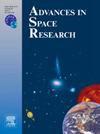Radiation-induced degradation in the properties of pristine and double-walled carbon nanotube-enhanced poly(2,5-benzimidazole) polymers for radiation shielding in the LEO
IF 2.8
3区 地球科学
Q2 ASTRONOMY & ASTROPHYSICS
引用次数: 0
Abstract
Degradation in the properties of polymer-based materials in space environments is a critical challenge for developing lightweight radiation shielding solutions. In this paper, a comparative study of the impacts of helium ion (He+) irradiation one of the ion species in the Low Earth Orbit (LEO) environment on the structural and optical properties of pristine and 1.0 wt% double-walled carbon nanotube (DWCNT)-enhanced poly(2,5-benzimidazole) (ABPBI) polymers for LEO radiation shielding applications was conducted. The two polymer categories were separately chemically prepared in the laboratory, moulded, dried, and cut into 1 cm × 1 cm pieces, and bombarded with 0.35 MeV He+ ions at varying fluences. The Ultraviolet–Visible-Near-Infrared (UV–Vis-NIR) optical analyses of the polymers following the ion bombardment revealed that He+ irradiation considerably raises the Urbach energy and decreases the optical bandgap, indicating a rise in electronic defects and structural disorder. On the other hand, the Fourier Transform Infrared (FTIR), Atomic Force Microscopy (AFM), and X-ray Diffraction (XRD) analyses revealed higher levels of structural degradation in the pristine ABPBI samples, suggesting changes brought about by irradiation-induced oxidation and chain scission processes. In contrast, the 1.0 wt% DWCNT-ABPBI composite demonstrated improved optical and structural integrity, retention, and resistance to He+ ion-induced damage. According to the results, 1.0 wt% DWCNT reinforcement reduces radiation-induced deterioration and offers more protection from energetic ion exposure in the LEO settings. Thus, this work highlights the distinct impact of He+ ion interactions with ABPBI and the effectiveness of DWCNT inclusion in improving polymer resilience, and it contributes to the fundamental understanding of the polymer composite for radiation shielding applications.
原始和双壁碳纳米管增强聚(2,5-苯并咪唑)聚合物在LEO中辐射屏蔽性能的辐射诱导降解
聚合物基材料在空间环境中性能的退化是开发轻型辐射屏蔽解决方案的关键挑战。本文对比研究了低地球轨道(LEO)环境中氦离子(He+)辐照对原始和1.0 wt%双壁碳纳米管(DWCNT)增强聚(2,5-苯并咪唑)(ABPBI)聚合物的结构和光学性能的影响。这两种聚合物分别在实验室化学制备,模压,干燥,切割成1厘米× 1厘米的块,并在不同的影响下用0.35 MeV He+离子轰击。离子轰击后聚合物的紫外-可见-近红外(UV-Vis-NIR)光学分析表明,He+辐照显著提高了乌尔巴赫能,减小了光学带隙,表明电子缺陷和结构紊乱增加。另一方面,傅里叶变换红外(FTIR)、原子力显微镜(AFM)和x射线衍射(XRD)分析显示,原始ABPBI样品的结构降解程度较高,表明辐照诱导的氧化和链断裂过程带来了变化。相比之下,1.0 wt%的dwcnts - abpbi复合材料表现出更好的光学和结构完整性、保持性和对He+离子诱导损伤的抵抗力。根据研究结果,1.0 wt%的DWCNT增强可以减少辐射引起的退化,并在LEO环境中提供更多的高能离子暴露保护。因此,这项工作强调了He+离子与ABPBI相互作用的独特影响以及DWCNT包合物在提高聚合物弹性方面的有效性,并有助于对聚合物复合材料辐射屏蔽应用的基本理解。
本文章由计算机程序翻译,如有差异,请以英文原文为准。
求助全文
约1分钟内获得全文
求助全文
来源期刊

Advances in Space Research
地学天文-地球科学综合
CiteScore
5.20
自引率
11.50%
发文量
800
审稿时长
5.8 months
期刊介绍:
The COSPAR publication Advances in Space Research (ASR) is an open journal covering all areas of space research including: space studies of the Earth''s surface, meteorology, climate, the Earth-Moon system, planets and small bodies of the solar system, upper atmospheres, ionospheres and magnetospheres of the Earth and planets including reference atmospheres, space plasmas in the solar system, astrophysics from space, materials sciences in space, fundamental physics in space, space debris, space weather, Earth observations of space phenomena, etc.
NB: Please note that manuscripts related to life sciences as related to space are no more accepted for submission to Advances in Space Research. Such manuscripts should now be submitted to the new COSPAR Journal Life Sciences in Space Research (LSSR).
All submissions are reviewed by two scientists in the field. COSPAR is an interdisciplinary scientific organization concerned with the progress of space research on an international scale. Operating under the rules of ICSU, COSPAR ignores political considerations and considers all questions solely from the scientific viewpoint.
 求助内容:
求助内容: 应助结果提醒方式:
应助结果提醒方式:


